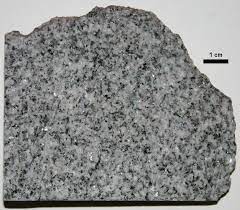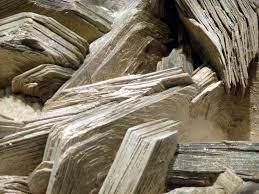Class 11 Geography NCERT Solutions Chapter 5 Minerals and Rocks
“Minerals and Rocks” is the fifth chapter of Class 11 Geography NCERT. We have prepared the Class 11 Geography NCERT Solutions Chapter 5 for your ready reference.
1. Multiple choice questions.
(i) Which one of the following are the two main constituents of granite?
(a) Iron and nickel (c) Silica and Aluminium
(b) Iron and silver (d) Iron Oxide and potassium
Ans: (c) Silica and Aluminium
Explanation: Granite is a type of igneous rock that is composed of several minerals. The two main constituents of granite are:
- Silica (Silicon Dioxide, SiO2): Silica is a major component of granite and is responsible for its crystalline structure. It provides the hardness and durability to the rock.
- Aluminium: Aluminum is another essential element found in granite. It is often present in minerals like feldspar and mica, which are common components of granite.

(ii) Which one of the following is the salient feature of metamorphic rocks?
(a) Changeable
(c) Crystalline
(b) Quite
(d) Foliation
Ans: (d) Foliation
Explanation: The salient feature of metamorphic rocks is foliation, which refers to the alignment of mineral grains in parallel layers or bands due to the intense pressure and heat they undergo during metamorphism. This gives metamorphic rocks a distinct layered or banded appearance. The other options are not specific characteristics of metamorphic rocks.

(iii) Which one of the following is not a single element mineral?
(a) Gold
(c) Mica
(b) Silver
(d) Graphite
Ans: (c) Mica
Explanation: Mica is not a single element mineral. It is a group of minerals that are characterized by their layered structure and are composed of various elements, including silicon, oxygen, aluminum, potassium, and others. Gold, silver, and graphite are examples of single element minerals.

(iv) Which one of the following is the hardest mineral?
(a) Topaz
(c) Quartz
(b) Diamond
(d) Feldspar
Ans: (b) Diamond
Explanation: Diamond is the hardest mineral known, ranking as 10 on the Mohs scale of mineral hardness. It is composed of carbon atoms arranged in a crystal lattice structure, which gives it exceptional hardness. The other minerals listed, including topaz, quartz, and feldspar, have lower levels of hardness compared to diamond.
(v) Which one of the following is not a sedimentary rock?
(a) Tillite
(c) Breccia
(b) Borax
(d) Marble
Ans: (d) Marble
Explanation: Marble is not a sedimentary rock. It is a metamorphic rock that forms from the recrystallization of limestone under high pressure and temperature. Tillite, breccia, and borax are examples of sedimentary rocks.
2. Answer the following questions in about 30 words.
(i) What do you mean by rocks? Name the three major classes of rocks.
Ans: Rocks are naturally occurring solid aggregates of minerals or mineral-like substances. The three major classes of rocks are igneous, sedimentary, and metamorphic.
(ii) What is an igneous rock? Describe the method of formation and characteristics of igneous rock.
Ans: An igneous rock forms from solidified molten material (magma or lava). It cools and crystallizes, producing interlocking mineral grains. Characteristics include texture, mineral composition, and extrusive or intrusive origin.
(iii) What is meant by sedimentary rock? Describe the mode of formation of sedimentary rock.
Ans: Sedimentary rocks originate from accumulated sediments through compaction and cementation. Erosion, transportation, deposition, and lithification lead to layering and various structures.
(iv) What relationship explained by rock cycle between the major type of rock?
Ans: The rock cycle depicts the reciprocal transformations among igneous, sedimentary, and metamorphic rocks. Igneous rocks cool from molten material, erode into sediments forming sedimentary rocks, which under pressure metamorphose into new rocks. These can melt to create magma, restarting the cycle, showcasing the Earth’s dynamic geological processes.
3. Answer the following questions in about 150 words.
(i) Define the term ‘mineral’ and name the major classes of minerals with
their physical characteristics.
Ans: A mineral is a naturally occurring inorganic substance with a specific chemical composition and a unique atomic structure. It forms the building blocks of rocks and Earth’s crust. Major classes of minerals, each with distinctive physical characteristics, include:
- Silicates: These minerals constitute the largest group and are based on the silicon-oxygen tetrahedron structure. Quartz, a silicate mineral, is hard, transparent, and has a hexagonal crystal shape.
- Carbonates: Carbonate minerals, such as calcite, contain carbonate ions. Calcite reacts with acid, and it often forms rhombohedral crystals.
- Sulfides: Sulfide minerals, like pyrite, are compounds of metal cations and sulfur anions. Pyrite’s metallic luster and cubic crystal structure are notable.
- Oxides: Oxide minerals, such as hematite, consist of metal cations bonded to oxygen. Hematite displays a characteristic reddish-brown color and can have either an earthy or metallic luster.
These minerals exhibit various physical properties, such as hardness, cleavage, luster, color, and specific gravity, making them distinguishable and essential for understanding Earth’s geological processes and history.
(ii) Describe the nature and mode of origin of the chief types of rock at the earth’s crust. How will you distinguish them?
Ans: The Earth’s crust is composed of three chief types of rocks: igneous, sedimentary, and metamorphic. Each type has a distinct nature and mode of origin, which can be differentiated based on various characteristics:
- Igneous Rocks:
- Nature: Igneous rocks form from the cooling and solidification of molten magma or lava. They can be either intrusive (formed underground) or extrusive (formed on the surface).
- Mode of Origin: Intrusive igneous rocks result from slow cooling and solidification beneath the Earth’s surface, leading to larger mineral crystals. Extrusive igneous rocks form from rapid cooling on the surface, resulting in smaller mineral crystals.
- Distinguishing Features: Grain size (coarse or fine), mineral composition, and texture (whether crystals are visible to the naked eye) are used to differentiate igneous rocks.
- Sedimentary Rocks:
- Nature: Sedimentary rocks are formed by the accumulation, compaction, and cementation of sediments (fragments of other rocks, minerals, and organic materials).
- Mode of Origin: Weathering and erosion break down existing rocks into sediments, which are then transported by agents like water, wind, or ice. Deposition occurs as the transporting agents lose energy, leading to sediment settling and compacting. Cementation involves minerals precipitating and binding the sediments together.
- Distinguishing Features: Sedimentary rocks often display visible layers or bedding, fossils, and a range of grain sizes depending on the original sediment.
- Metamorphic Rocks:
- Nature: Metamorphic rocks are the result of pre-existing rocks (igneous, sedimentary, or other metamorphic) undergoing changes due to increased heat and pressure.
- Mode of Origin: Regional metamorphism occurs over large areas due to tectonic forces, resulting in foliated rocks with aligned mineral grains. Contact metamorphism happens near igneous intrusions, leading to non-foliated rocks with recrystallized minerals.
- Distinguishing Features: Foliated metamorphic rocks show visible layering or alignment of minerals, while non-foliated rocks lack this feature.
In summary, the nature and mode of origin of each rock type are influenced by geological processes such as cooling, erosion, compaction, and metamorphism. Distinguishing features include texture, mineral composition, presence of layers, and the conditions under which they formed.
(iii) What are metamorphic rocks? Describe the types of metamorphic rock and how are they formed?
Ans: Metamorphic rocks are a type of rock that forms from the alteration of pre-existing rocks, called parent rocks, under increased heat, pressure, or chemically active fluids. This transformation occurs without melting the rock entirely. Metamorphism leads to changes in mineral composition, texture, and often results in the development of distinct layering or alignment of mineral grains.
Types of Metamorphic Rocks:
- Foliated Metamorphic Rocks:
- Examples: Schist, gneiss, slate.
- Formation: Foliated rocks result from regional metamorphism, caused by tectonic forces over large areas. High pressure and temperature cause minerals to realign, producing distinct layers.
- Characteristics: Foliated rocks display visible bands or layers of minerals, with the mineral alignment creating a foliated texture.
- Non-Foliated Metamorphic Rocks:
- Examples: Marble, quartzite, hornfels.
- Formation: Non-foliated rocks typically form from contact metamorphism, which occurs when rocks come into contact with hot magma or lava. The heat causes recrystallization without the development of layering.
- Characteristics: Non-foliated rocks lack the distinct layering seen in foliated rocks, and their mineral grains may be interlocking rather than aligned.
Formation of Metamorphic Rocks:
- Heat and Pressure: Increased temperature and pressure from tectonic forces or deep burial cause minerals within the parent rock to recrystallize and reorganize into new mineral structures.
- Chemically Active Fluids: Hot fluids containing dissolved minerals can facilitate chemical reactions between minerals in the parent rock, leading to mineral changes and recrystallization.
- Burial and Uplift: Rocks subjected to burial and later uplift due to geological processes experience changes in pressure and temperature, initiating metamorphic transformations.
- Contact Metamorphism: Rocks near a heat source, such as an igneous intrusion, undergo changes due to the elevated temperature of the surrounding environment.
Metamorphic rocks provide insights into the Earth’s geological history, as the conditions of their formation reveal the dynamic processes that have shaped the crust over time. The type of metamorphic rock formed depends on factors such as the composition of the parent rock, the intensity of heat and pressure, and the presence of chemically active fluids.
Thanks for reading Class 11 Geography NCERT Solutions Chapter 5 Minerals and Rocks.
Read
